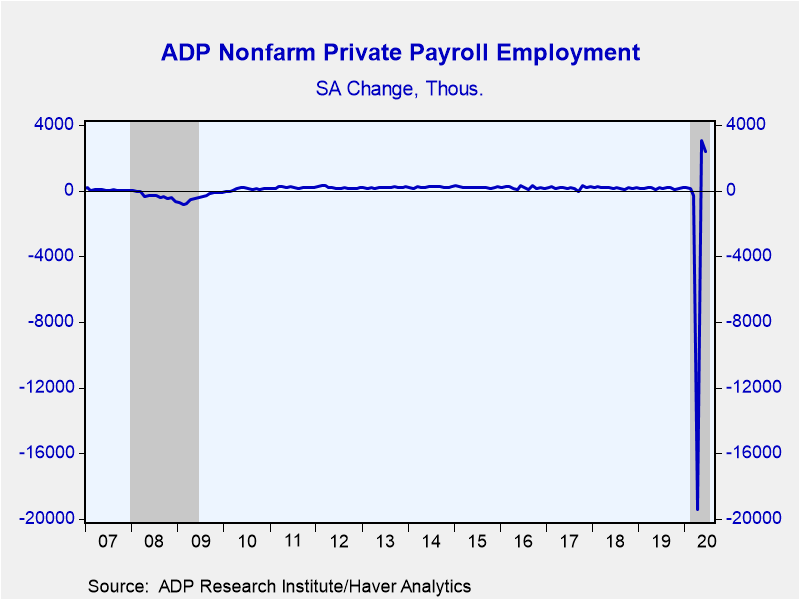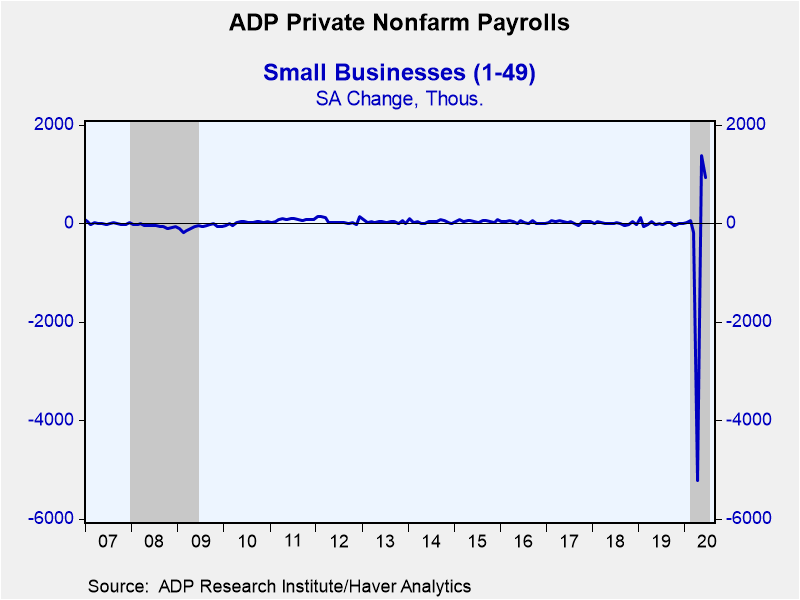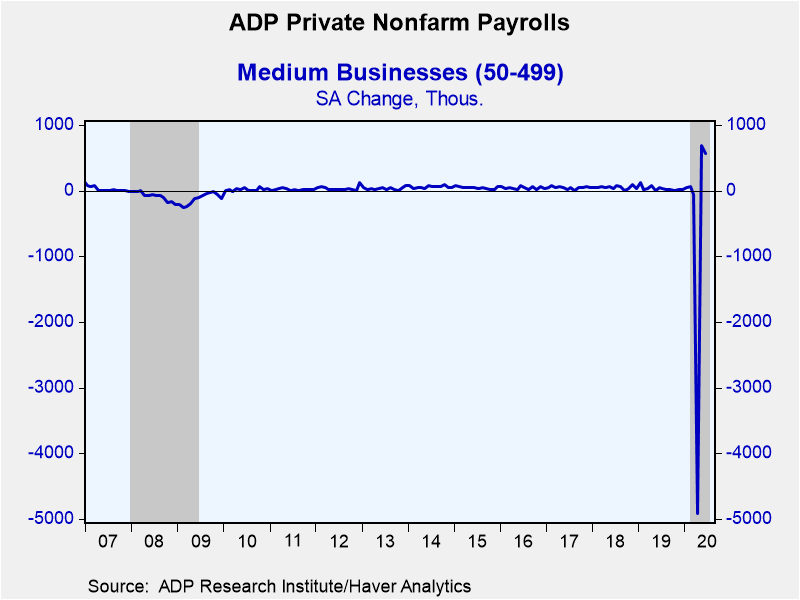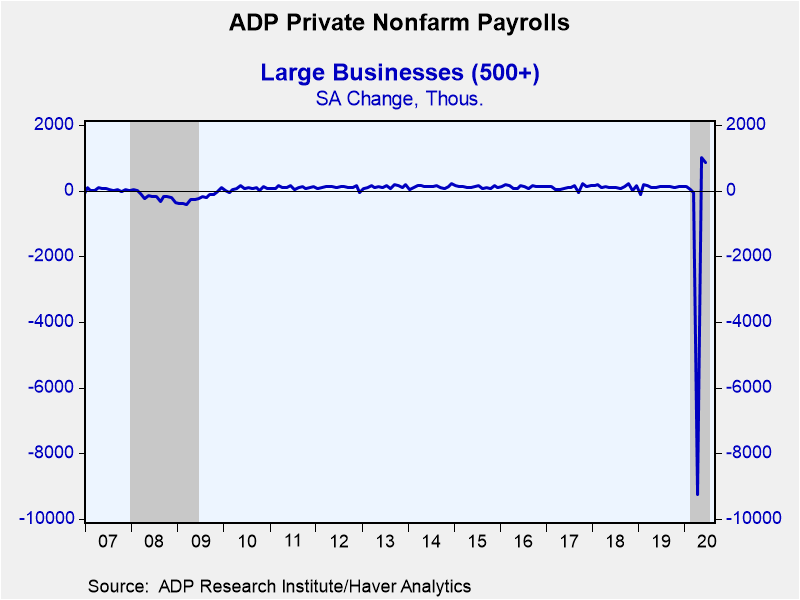 Global| Jul 01 2020
Global| Jul 01 2020U.S. ADP Nonfarm Private Payrolls Rise 2.369 Million in June
by:Tom Moeller
|in:Economy in Brief
Summary
• Employment increased in May rather than declined. • June's gains are spread across industry sectors. The job market continued to expand last month. The ADP National Employment Report indicated that nonfarm private payrolls during [...]
• Employment increased in May rather than declined.
• June's gains are spread across industry sectors.
The job market continued to expand last month. The ADP National Employment Report indicated that nonfarm private payrolls during June increased 2.369 million following a 3.065 million rise during May, last month reported as a 2.760 million decline. Upward revisions spread across industry sectors. April's 19.409 million decline was revised from a 19.557 million shortfall. The latest figure compared to a 3.000 million increase expected in the Action Economics Forecast Survey. The ADP report is based on data through June 12.
Small payrolls improved 937,000 last month (-9.1% y/y) after strengthening 1.371 million, revised from a 435,000 decline. Large payrolls increased 873,000 (-10.0% y/y) after rising 1.010 million in May, revised from a 1.604 million decline. Medium-sized payrolls followed with a 559,000 increase (-11.7% y/y) after gaining 685,000, revised from a 722,000 decline.
Within industry sectors, employment amongst goods-producing firms rose 457,000 after increasing 662,000, revised from a 794,000 fall. The size of construction sector payrolls improved 394,000 last month after gaining 462,000, revised from a 22,000 fall. Factory sector employment improved 88,000 following a 220,000 increase, revised from a 719,000 shortfall. Employment in the natural resource & mining sector eased 26,000 (-15.4% y/y), continuing a long pattern of decline.
Employment in the private service sector improved 1.912 million in June after a 2.403 million rise, revised from a 1.967 million decline. A 288,000 increase (-8.3% y/y) in trade, transportation & utilities came after a 362,000 rise that was initially reported as a 826,000 decline. Employment in the professional & business services sector gained 151,000 (7.7% y/y) after improving 125,000 in May, revised from a 250,000 weakening. A 961,000 increase (-31.6% y/y) in the leisure & hospitality area followed a 1.232 million increase, revised from a 105,000 decline. Employment in the financial services sector rose 65,000 (-0.9% y/y) after a 32,000 decline, revised from a 196,000 decline. Education & health services jobs surged 283,000 (-6.0% y/y) on the heels of a 421,000 gain, revised from a drop of 168,000. Information sector payrolls fell 50,000 (-12.5% y/y) after a 38,000 decline, revised from -115,000.
The Automatic Data Processing Research Institute survey covers 411,000 companies and includes about one-fifth of U.S. private payroll employment. The data are processed by Moody's Analytics Inc., then calibrated and aligned with the BLS establishment survey data. The ADP data cover private sector employment only.
The ADP National Employment Report data can be found in Haver's USECON database. Historical figures date back to 2001 for private employment and the industry breakdown, and 2005 for the business size breakout. The expectation figure is available in Haver's AS1REPNA database.
The minutes to the latest FOMC meeting can be found here.
| ADP/Moody's National Employment Report | Jun | May | Apr | Jun Y/Y | 2019 | 2018 | 2017 |
|---|---|---|---|---|---|---|---|
| Nonfarm Private Payroll Employment (m/m chg, 000s) | 2,369 | 3,065 | -19,409 | -10.2% | 1.5% | 1.8% | 1.7% |
| Small Payroll (1-49) | 937 | 1,371 | -5,217 | -9.1 | 0.2 | 0.6 | 1.1 |
| Medium Payroll (50-499) | 559 | 685 | -4,923 | -11.7 | 2.0 | 2.0 | 1.9 |
| Large Payroll (>500) | 873 | 1,010 | -9,269 | -10.0 | 1.9 | 2.3 | 2.0 |
| Goods-Producing | 457 | 662 | -2,350 | -5.8 | 1.6 | 2.9 | 1.8 |
| Construction | 394 | 462 | -972 | -0.6 | 2.7 | 4.1 | 3.7 |
| Manufacturing | 88 | 220 | -1,329 | -8.2 | 1.0 | 1.9 | 0.8 |
| Service-Producing | 1,912 | 2,403 | -17,059 | -11.0 | 1.5 | 1.6 | 1.7 |
Tom Moeller
AuthorMore in Author Profile »Prior to joining Haver Analytics in 2000, Mr. Moeller worked as the Economist at Chancellor Capital Management from 1985 to 1999. There, he developed comprehensive economic forecasts and interpreted economic data for equity and fixed income portfolio managers. Also at Chancellor, Mr. Moeller worked as an equity analyst and was responsible for researching and rating companies in the economically sensitive automobile and housing industries for investment in Chancellor’s equity portfolio. Prior to joining Chancellor, Mr. Moeller was an Economist at Citibank from 1979 to 1984. He also analyzed pricing behavior in the metals industry for the Council on Wage and Price Stability in Washington, D.C. In 1999, Mr. Moeller received the award for most accurate forecast from the Forecasters' Club of New York. From 1990 to 1992 he was President of the New York Association for Business Economists. Mr. Moeller earned an M.B.A. in Finance from Fordham University, where he graduated in 1987. He holds a Bachelor of Arts in Economics from George Washington University.










